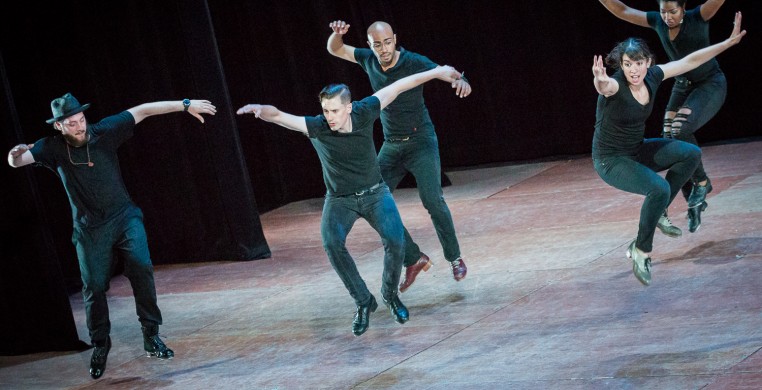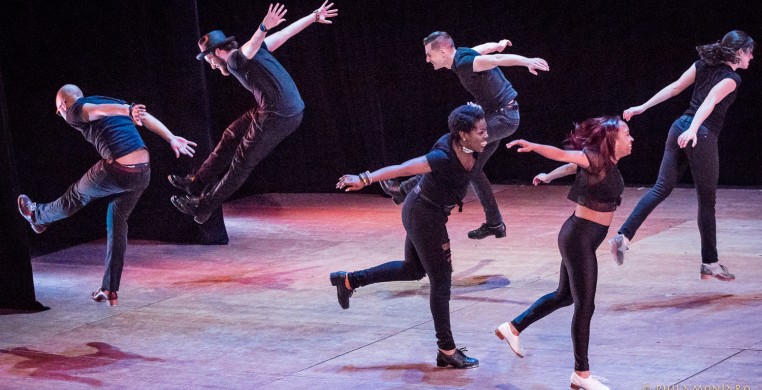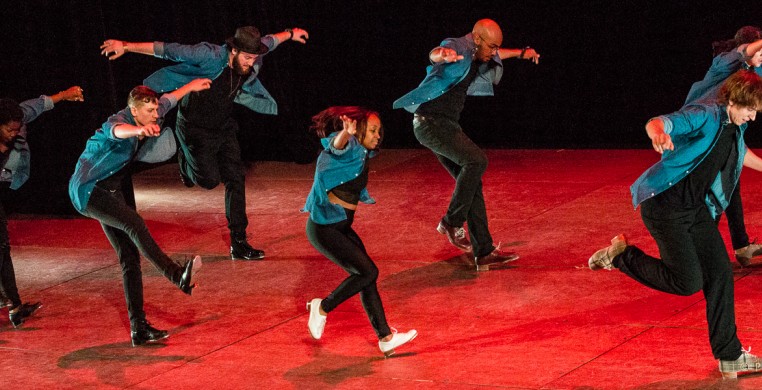Performing at The Dance Center for the first time in ten years this past Thursday through Saturday, the Chicago Human Rhythm Project stirs the traditional tap dance pot with “Stone Soup Rhythms,” curated by Swiss-born artist-in-residence Daniel Borak. The collection of tap dance works takes its title from a well-known folk tale in which villagers each contribute one ingredient to the communal soup pot, creating together a rich and tasty meal.
“Stone Soup Rhythms” spices up tradition, beginning with a classic tap dance number from the annals of vaudeville, “Big Diesel Going North,” by Lon Chaney, and then melding into Borak’s innovative “Dani Mix.” The unison rhythms of the historic work combines crisp footwork, claps, and body percussion in a fun, fast-paced tap dance primer that forms the basis for everything that follows.
Borak’s infectious enthusiasm for movement transfers across the Dance Center’s expansive performance space with a winning smile and whole-body choreography that blends traditional tap with jazz dance, hip-hop, and funk genres. He gives each of his seven dancers a chance to shine in riffs that show off impressive tap licks without sacrificing overall movement flow of the piece.
His duet, “The Entertainer,” with pianist and MacArthur Genius recipient Reginald Robinson is a gem of artistic partnering, each performer playing the familiar Scott Joplin music on his own instrument, each accompanying and enhancing the other in a seamless exchange of syncopated syllables. Borak’s subtle tactile realization of Joplin’s melodies as he circles the piano, the multiples of beats and accents he discovers in the rag-time rhythms of the music, combine with Robinson’s fleet keyboard fingering to create a delicious confection of melodic and percussive rhythms and movement.
CHRP Dancer Earlyn Whitehead’s quartet, “Woven Recognitions,” set to electronic sound design by Adam Crawley, features three dancers in sneakers and one in tap shoes. In an abstract drama of cause and effect, the tapping male dancer’s audible movement is a catalyst for the silent swings, falls to the floor, spins, jumps, and pulsations of the inaudible trio. Windswept and tossed by currents of energy from one body to the next, the piece explores the use of tapped rhythms—both audible and inaudible—in the context of modern dance choreographic structure. In a movement motif that repeats throughout the piece, the tapper crouches low to the ground and sweeps his leg, transcribing a broad arc along the floor, his tap shoe producing an amplified slur of sound that activates the other three. Whitehead gets her dancers down on the floor and into the air in group spatial patterns with whole-body gestures that make a radical, and fascinating, departure from traditional tap dance choreography.
Pushing the boundaries of conventional tap in a completely different direction, MacArthur Genius recipient Michelle Dorrance’s “Push Past Break” opens with spitfire dancer Donnetta Jackson going 150 miles an hour, tapping a fury of rapid-fire vibrations in a desperate race to nowhere against a slow crooning St. Louis Blues. Two male dancers, in sleeveless black vests and slacks appear upstage of her with the deliberately-clichéd moves of nightclub back-up singers. Gradually the stage becomes populated with two more women in 40’s period dresses for a unison couples dance, Jackson participating on the side. A guitar and vocals ballad begins a sequence of discrete segments, first a trio for the women, then a male solo to “I’m So Lonesome I Could Die,” and culminating in an ensemble a cappella rhythm collage to Jackson’s wonderfully poignant on-stage, singing, “anyhere I can, anywhere I can….” A subtle lament infuses the whole with a hint of pathos, the four other dancers joining in with surprisingly good back-up vocal harmonies. Again, departing from the traditional focus on rhythmic footwork alone, a blend of the audible tapped percussive patterns, singing, and full-body choreography created a rich movement landscape.
Contributing another distinctive ingredient to “Stone Soup Rhythms,” New York Broadway prodigy Cartier Williams, in red baseball cap and torn jeans, combined hip-hop, funk, and extraordinary tap technique in two segments of “ZigettyBop!” The first begins as an a cappella duet for himself and Daniel Borak in a joyful tribute to the dueling tap tradition of one-upmanship through motif and development, and spins off to the music of Jim Johnson’s “Are Your Ready.” Cartier’s second “ZiggetyBop” manages to use the tap idiom in an emotional, soul-searching solo to the waltz-time guitar ballad of “Maggot Brain” by Funkadelic.
In between, Reginald Robinson returned for a second solo set of piano jazz, a pleasant interlude that paused tap action for a kind of auditory palette-cleansing.
Concluding the program were Borak’s “Rytme” and “Fusion,” a techno-modern foray into stop-action moves, complete with day-glow facial warpaint, arm and leg bands, and the driven pulse of “Take A Quick Break,” by Bugge Wesseltoft, Henrik Schwarz, and Dan Berglund. Tazer twitches, falls to the floor, foot-stomping, and melting movement combined with complex tap rhythms in a dooms-day vision of a future we hope we never have to face.




